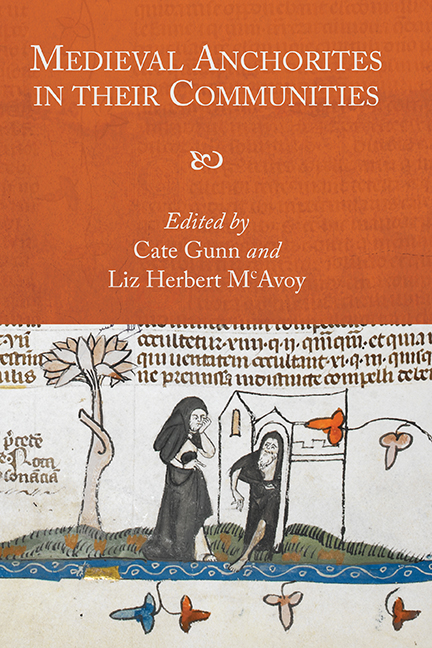Book contents
- Frontmatter
- Dedication
- Contents
- List of Illustrations
- Acknowledgements
- List of Contributors
- Abbreviations
- Introduction: ‘No Such Thing as Society?’ Solitude in Community
- 1 ‘O Sely Ankir!’
- Part I Religious Communities
- Part II Lay Communities
- 5 English Nuns as ‘Anchoritic Intercessors’ for Souls in Purgatory: The Employment of A Revelation of Purgatory by Late Medieval English Nunneries for Their Lay Communities
- 6 ‘In aniversaries of ower leoveste freond seggeth alle nihene’: Anchorites, Chantries and Purgatorial Patronage in Medieval England
- 7 ‘Item receyvyd of ye Anker’: The Relationships between a Parish and its Anchorites as Seen through the Churchwardens’ Accounts
- 8 The Curious Incident of the Hermit in Fisherton
- 9 Was Julian's Nightmare a Māre? Julian of Norwich and the Vernacular Community of Storytellers
- Part III Textual Communities
- Bibliography
- Index
- Miscellaneous Endmatter
6 - ‘In aniversaries of ower leoveste freond seggeth alle nihene’: Anchorites, Chantries and Purgatorial Patronage in Medieval England
from Part II - Lay Communities
Published online by Cambridge University Press: 30 August 2017
- Frontmatter
- Dedication
- Contents
- List of Illustrations
- Acknowledgements
- List of Contributors
- Abbreviations
- Introduction: ‘No Such Thing as Society?’ Solitude in Community
- 1 ‘O Sely Ankir!’
- Part I Religious Communities
- Part II Lay Communities
- 5 English Nuns as ‘Anchoritic Intercessors’ for Souls in Purgatory: The Employment of A Revelation of Purgatory by Late Medieval English Nunneries for Their Lay Communities
- 6 ‘In aniversaries of ower leoveste freond seggeth alle nihene’: Anchorites, Chantries and Purgatorial Patronage in Medieval England
- 7 ‘Item receyvyd of ye Anker’: The Relationships between a Parish and its Anchorites as Seen through the Churchwardens’ Accounts
- 8 The Curious Incident of the Hermit in Fisherton
- 9 Was Julian's Nightmare a Māre? Julian of Norwich and the Vernacular Community of Storytellers
- Part III Textual Communities
- Bibliography
- Index
- Miscellaneous Endmatter
Summary
ACCORDING to Jacques Le Goff, the use of the word purgatorium, ‘purgatory’, as a noun appeared somewhere between 1160 and 1180, giving rise to the idea of purgatory as an actual place. Although some have challenged this contention, Le Goff's premise, particularly in connection to the spatial arrangement of the medieval afterlife, is an important basis for any examination of purgatorial strategy. Le Goff suggests that European culture underwent a shift from seeing the world as a series of binary structures to tripartite ones. Theologically, ‘people began to speak of the medium (mediocriter) good or medium wicked’, instead of the wholly good or wholly wicked, thus creating a category of people who needed both the cleansing of purgatorial fires and the intercession of others to escape such, and elaborate bookkeeping metaphors to keep track. Still, theologians did not officially define the doctrine of purgatory until the thirteenth century. Defined clearly or not, however, medieval people were generally taught that purgatory was a period in which the soul passed from death to salvation, and a place where sins were expunged by every kind of physical torment before final redemption. As such, it was both a temporal state and a physical state. Indeed, while officially the suffering endured in purgatory stems from the separation of the soul from God, the difficulty in comprehending the ineffable led to descriptions of purifying flames and other torments. And, because purgatory was inevitable, preparation for intercession, especially through reciprocal obligation such as friendship, grew in importance.
Allusions to purgatory begin cropping up in early Middle English literature, even before being formally named as such. For instance, Cate Gunn notes that ‘Vices and Virtues, a Middle English dialogue between the soul and Reason … written at the turn of the thirteenth century … does not contain any mention of purgatory, but it does refer to purgatorial cleansing and the possibility that the suffrages of the living can aid the dead.’ However, the first known reference in English to purgatory as a noun meaning ‘a place or condition of temporal punishment for the spiritual cleansing after death of souls destined for heaven’, occurs in the thirteenth-century anchoritic guidance text, Ancrene Wisse (Cambridge, Corpus Christi College 402).
- Type
- Chapter
- Information
- Medieval Anchorites in their Communities , pp. 101 - 116Publisher: Boydell & BrewerPrint publication year: 2017



